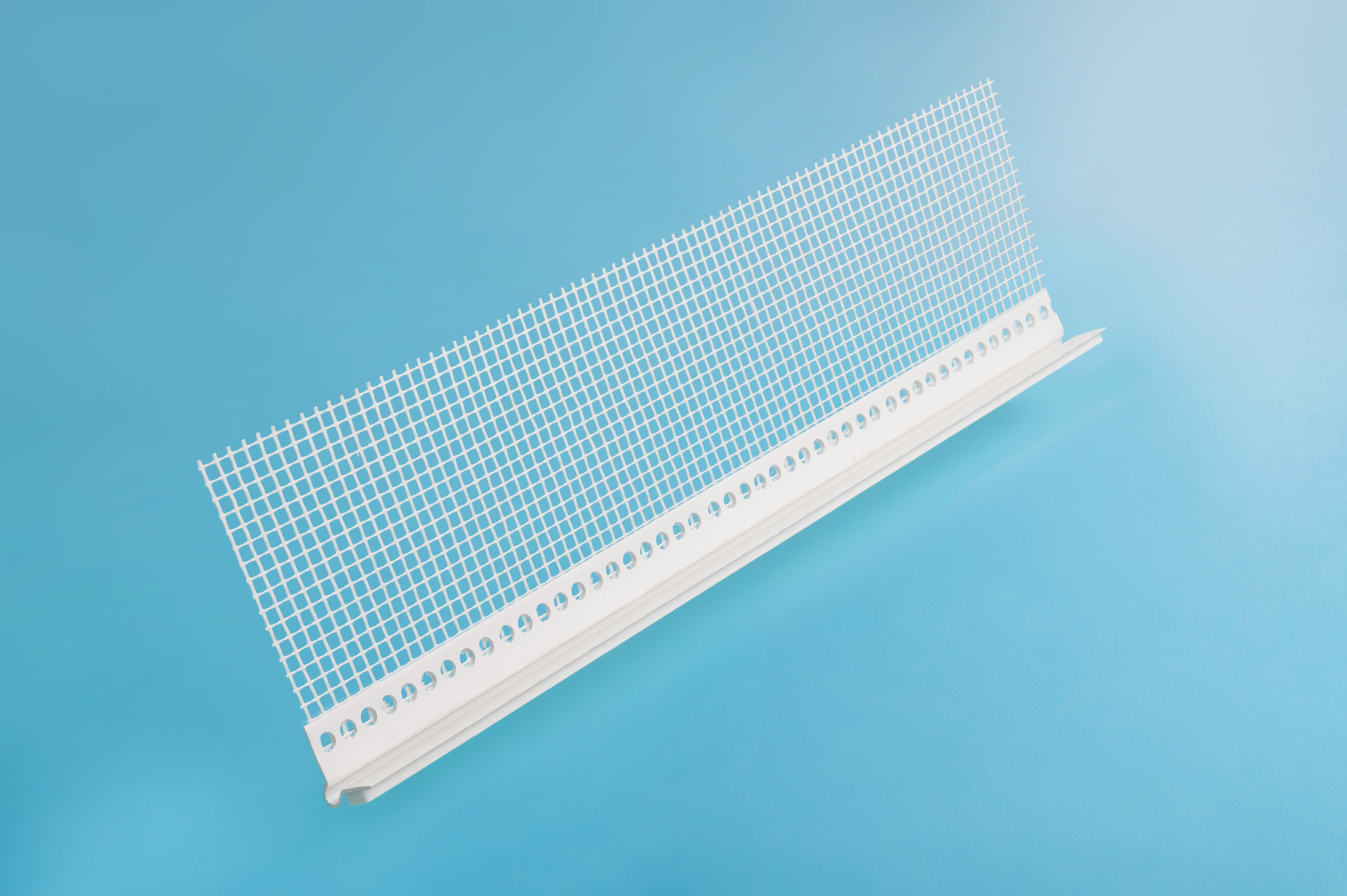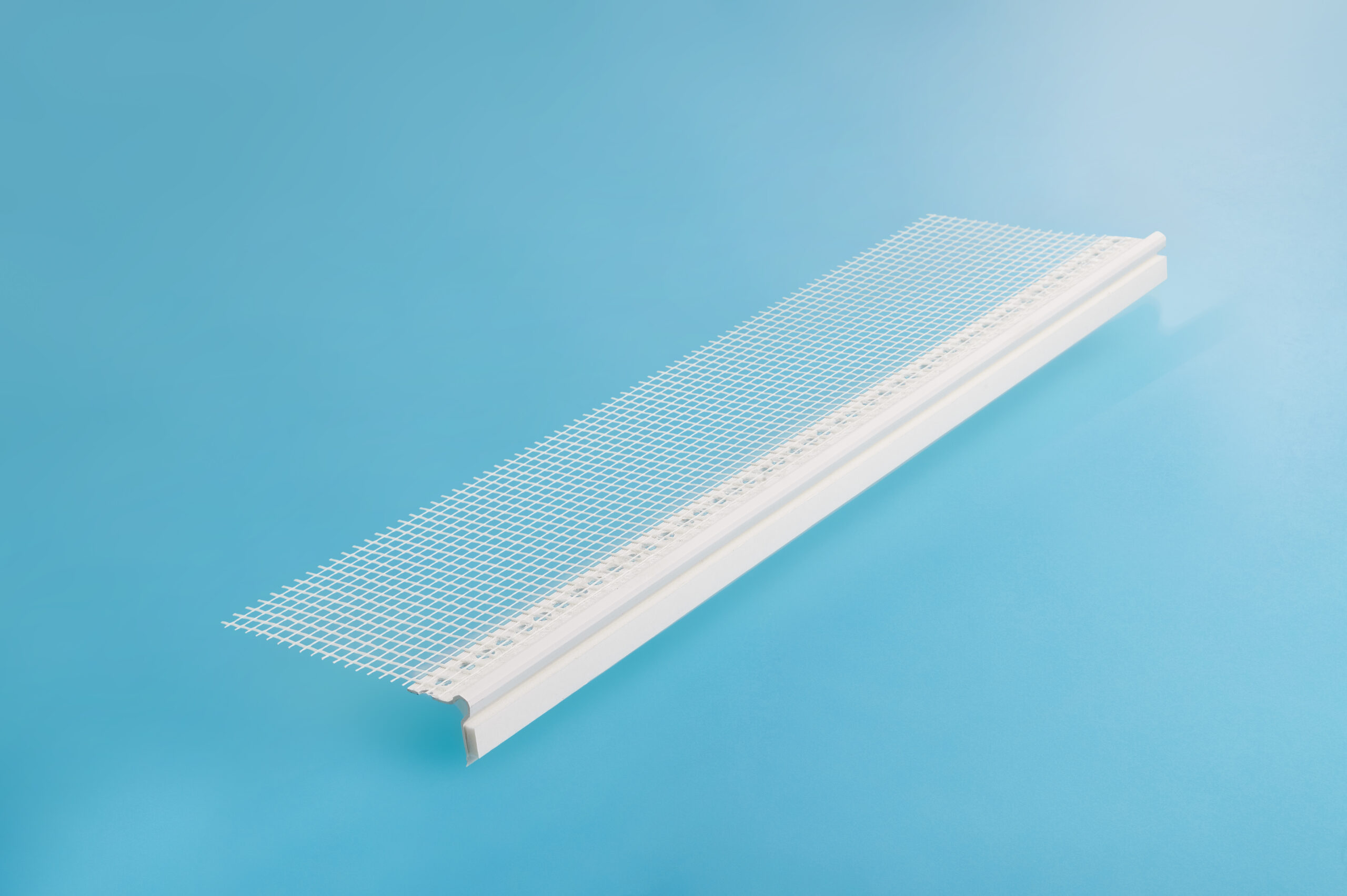

Plastic Under Window Sill Profile with Dilatation Foam and Mesh
Interior works
Technical characteristics
Type of profile: for a windowsill
Kind of profile: with reinforcing mesh
Material: PVC
Length, m: 2.0
Width, mm: 100
Quantity in the package, pcs.: 25
for joining a windowsill (made of PVC, steel, stone, galvanized materials) to a thermal lining.
reliable joining of the windowsill to the thermal lining;
preventing the occurrence of a thermal bridge in the windowsill;
protection against cold, noise, and whistling wind.
The plastic windowsill profile is installed between the windowsill and the thermal lining. Foamed polyethylene and fibreglass mesh are placed on the profile surface. One should stick the profile under the windowsill, having previously cleaned and degreased it. The profile mesh should be pressed into the adhesive. The next stage is to cover it with a facade reinforcing mesh with an indent.
Plastic Under Window Sill Profile with Dilatation Foam and Mesh: A Reliable Choice for Durable and Aesthetic Finishing
It is an essential element in modern construction and renovation, providing secure fixing and attractive finishing for window sills. This profile creates a smooth and long-lasting joint between the window sill and the wall, significantly enhancing the aesthetic appeal of the window opening and improving its functional performance. In this article, we will explore in detail the advantages of using a plastic under window sill profile, its interaction with other construction materials such as sealing profiles, corner expansion profiles, guide beacons, and plastering corners, as well as its key features.
What is the Plastic Under Window Sill Profile with Dilatation Foam and Mesh?
The Plastic Under Window Sill Profile with Dilatation Foam and Mesh is a specialized component used to connect the window sill to the wall or other elements of the window opening. It is manufactured from high-quality plastic, ensuring excellent resistance to external factors such as moisture, temperature fluctuations, ultraviolet radiation, and mechanical damage. Thanks to its versatility and ease of installation, this profile has become a popular choice among builders and designers seeking both functionality and modern aesthetics.
Key Functions of the Plastic Under Window Sill Profile
- Moisture Protection: The profile prevents moisture from penetrating the joint between the window sill and the wall, significantly extending the service life of the sill and increasing its resistance to mold and fungal growth.
- Ensuring a Uniform Joint: Using this plastic profile creates a smooth, neat seam that delivers an aesthetically appealing look to the window opening.
- Movement Compensation: The profile accommodates potential movements of the window sill due to temperature fluctuations or building settlement, thereby preventing the formation of cracks.
Advantages of the Plastic Under Window Sill Profile
- Durability and Resilience. Manufactured from high-grade materials, the Plastic Under Window Sill Profile offers outstanding resistance to external influences. It does not corrode or change its properties under the effects of UV radiation and moisture, ensuring a long service life even in harsh conditions.
- Easy Installation. This profile is designed for simple mounting on window sills, significantly simplifying the installation process. Its flexibility and light weight allow for quick and convenient fixing, reducing labor costs and installation time.
- Cost-Effectiveness. The use of the Plastic Under Window Sill Profile is an economically advantageous solution as it requires minimal maintenance and infrequent repairs. Its installation and operation provide reliable protection and an attractive finish for the window sill without incurring additional expenses.
- Aesthetic Appeal. Available in a range of colors and textures, this plastic profile allows you to select the perfect option for any interior. It adds a finished look to the window opening and enhances the overall aesthetic appeal of the space.
Applications of the Plastic Under Window Sill Profile
- Window Sill Finishing. The primary application of the plastic profile is for finishing and protecting the joint between the window sill and the wall. It creates an even and airtight seam that not only protects against moisture but also improves the thermal and sound insulation properties of the window sill.
- Interior Decoration. This profile is widely used in interior finishing, where it helps create neat and uniform joints between different interior elements, thereby enhancing the overall aesthetic value of the space.
- Renovation and Repairs. During building renovations or repairs, the plastic under window sill profile helps restore and reinforce the connection between the window sill and the wall, increasing their resistance to external influences and ensuring the durability of the structure.
Interaction with Other Construction Materials
- Sealing Profile: A sealing profile is used to ensure airtight joints and seams in construction. Combined with the plastic window sill profile, it provides extra protection against moisture and dust, enhancing durability.
- Corner Expansion Profile: The corner expansion profile compensates for movements in angular joints. When used together with the window sill profile, it ensures reliable sealing and protects the joints from cracks and deformations.
- Screed guide: A guide beacon is used to level walls before applying plaster or other finishing materials. It ensures a smooth surface that is essential for the proper fixing of the window sill profile, contributing to an aesthetically pleasing finish.
- Plastering Corner: The plastering corner is used to protect and align the corners of building structures. When combined with the window sill profile, it helps create crisp, even lines at the joints, thereby enhancing both the visual appeal and durability of the finish.